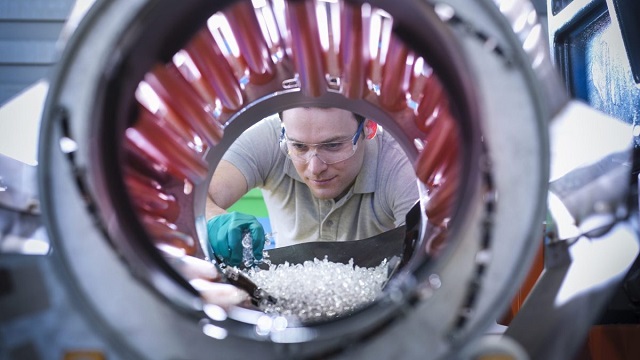Alberta
How natural gas supports one of Canada’s largest manufacturing sectors

Worker inspecting parts from plastic injection moulding machine in plastics factory. Getty Images photo
From the Canadian Energy Centre
‘When you think about the demand for more sustainable outcomes: clean air, clean water, clean energy, safe, nutritious, abundant food and electric vehicles, that’s more and more and more chemistry’
Canada’s chemical industry sold a record $72.7 billion of product last year amid recovery from COVID-19 and strong consumer demand, according to the Chemistry Industry Association of Canada (CIAC).
Natural gas is a key input to the chemistry sector, the broad term that refers to manufacturing a myriad of products used in everyday items from plastics to agriculture and pharmaceuticals.
“Chemistry products go into 95 per cent of finished goods. It’s an important sector,” says CIAC president Bob Masterson.
“It’s a sector that can grow as long as we fancy improving our lives and building a better world for tomorrow.”
Chemicals in Canada
Canada’s chemistry industry is the country’s fourth largest manufacturing sector by value of sales after food ($147 billion), transportation equipment ($119 billion), and petroleum/coal products ($118 billion).
It is primarily centered in Ontario, Alberta and Quebec.
The CIAC publishes an annual report on the sector’s activity using Statistics Canada data, separated into two categories: chemicals overall, and industrial chemicals.
Chemicals overall includes manufacturing of soaps, cleaning compounds, paints, coatings and adhesives, pesticides and fertilizers, pharmaceuticals, rubbers and synthetic fibres, and basic chemicals.
Industrial chemicals refers to the manufacturing of intermediate products used as inputs by industries including plastic and rubber products, forest products, transportation equipment, clothing, perfume and cosmetics, construction and pharmaceuticals.
Global Growth
According to Vantage Market Research, the global chemical market was valued at US$584 billion in 2022. It’s expected to grow by more than 55 per cent in the coming years to reach US$917 billion by 2030.
This isn’t just driven population growth, Masterson says.
“When you think about the demand for more sustainable outcomes: clean air, clean water, clean energy, safe, nutritious, abundant food and electric vehicles, that’s more and more and more chemistry,” he says.
“Some of the predictions are that the volumes of chemistry will double in the next 20 years. Canada and Alberta in particular are exceptionally well positioned to help meet future market demand for these products. The demand is not going away. There’s no question about that.”
Jobs
In 2022, Canada’s chemicals sector directly employed 90,800 people, or approximately the population size of Sudbury, Ontario. The industry paid about $7 billion in salary and wages.
That’s the direct impact of employment in the chemistry sector, but the CIAC estimates the full benefit to Canadians to be much higher as a result of indirect economic activity it supports.
CIAC estimates that every job in Canada’s chemistry sector creates another five indirect jobs in other parts of the economy. This means the sector supported 454,000 jobs across Canada in 2022.
Industrial chemicals alone directly employed 17,100 people and indirectly supported 85,600 jobs in the broader Canadian economy last year, the CIAC says.
Rising Trade
At a value of $72.7 billion, Canada’s overall chemical industry sales were their highest ever in 2022 – a 30 per cent increase compared to 2019, prior to the COVID-19 pandemic.
Industrial chemicals sales reached a record $34.2 billion, a 32 per cent increase compared to 2019.
Exports also increased last year, rising to a value of $52.8 billion compared to $45.9 billion in 2021. Of that, the sector exported $24.8 billion of industrial chemicals, up from $22.5 billion the previous year.
The United States is Canada’s main customer for chemical exports, representing 76 per cent of exports or $40.1 billion in 2022. The next largest export markets are China ($1.86 billion), the Netherlands ($1.7 billion), and the United Kingdom ($1.1 billion).
The Canada Advantage
Canada has distinct advantages as a chemical manufacturer and exporter including growing access to global markets, CIAC says.
In Alberta, the main advantage is access to low-cost natural gas resources – specifically valuable natural gas liquids like ethane, propane and butane.
“The rich abundance of natural gas liquids that come out of the ground when we drill for natural gas let Alberta be a low-cost chemistry producer despite being pretty much the only large chemistry industry worldwide that’s not on tidewater,” Masterson says.
Responsible Care
Since 1985, Canada’s chemistry industry has operated under an initiative called Responsible Care that encourages companies to innovate for safer and greener products.
CIAC reports that Responsible Care is now practiced in 73 countries and by 96 of the 100 largest chemical producers in the world.
Since 2005, CIAC members have reduced CO2 equivalent emissions by 13 per cent; reduced sulphur dioxide emissions by 94 per cent, and virtually eliminated large scale safety incidents. Since 2012, CIAC members have also reduced net water consumption by 13 per cent.
“We’re not standing in place,” Masterson says.
Alberta
Diploma Exams Affected: No school Monday as ATA rejects offer of enhanced mediation

Premier Danielle Smith, Minister of Finance Nate Horner, and Minister of Education Demetrios Nicolaides issued the following statement.
“Yesterday, the Provincial Bargaining and Compensation Office wrote to the Alberta Teachers’ Association (ATA) and formally requested an agreement to enter an enhanced mediation process.
“This process would have ensured that students returned to the classrooms on Monday, and that teachers returned to work.
“Negotiating would have continued with the ATA, Teachers’ Employer Bargaining Association (TEBA) and a third-party mediator to propose a recommended agreement.
“We are very disappointed that the Alberta Teachers’ Association refused this offer. Teachers and students should also be disappointed.
“PBCO made this offer to the ATA because the union has not made a reasonable offer and this strike is impacting students. Alberta’s government is trying to put kids first and bring an end to this strike.
“The offer of enhanced mediation provided a clear path to ending it.
“We want the same things as the ATA: More teachers. More pay for teachers. More educational assistants. And more classrooms.
“This strike has gone on too long and we are extremely concerned about the impact it is having on students.
“We are willing to consider further options to ensure that our next generation gets the world-class education they deserve. After about three weeks, a strike of this nature would reach the threshold of causing irreparable harm to our students’ education.
“The ATA needs to do what is right for its members, and for all Alberta students.
“If it refuses to do so, we will consider further options to bring this strike to an end.”
Diploma exam update
November diploma exams will be optional for students.
With instructional time in schools disrupted due to the teacher strike, the November 2025 diploma exams will now be optional for students. Students who wish to write a diploma exam may request to do so, and their school boards will accommodate the request.
The optional diploma exams apply to all schools provincewide. These exams will still take place on the currently scheduled dates.
Students who choose not to write the November diploma exams can still complete their courses and graduate on time. Their final grade will be based entirely on the school-awarded mark provided by their teacher.
Choosing not to write the November diploma exams will not affect a student’s ability to apply to, be accepted by, or attend post-secondary institutions after graduation.
No changes have been made to the January and June diplomas and provincial achievement tests.
Quick facts
- Students are automatically exempted from writing the November diploma exams but can request to write them.
- School boards must allow the student to write the diploma exam if requested.
Alberta
Alberta taxpayers should know how much their municipal governments spend

From the Fraser Institute
By Tegan Hill and Austin Thompson
Next week, voters across Alberta will go to the polls to elect their local governments. Of course, while the issues vary depending on the city, town or district, all municipal governments spend taxpayer money.
And according to a recent study, Grande Prairie County and Red Deer County were among Alberta’s highest-spending municipalities (on a per-person basis) in 2023 (the latest year of comparable data). Kara Westerlund, president of the Rural Municipalities of Alberta, said that’s no surprise—arguing that it’s expensive to serve a small number of residents spread over large areas.
That challenge is real. In rural areas, fewer people share the cost of roads, parks and emergency services. But high spending isn’t inevitable. Some rural municipalities managed to spend far less, demonstrating that local choices about what services to provide, and how to deliver them, matter.
Consider the contrast in spending levels among rural counties. In 2023, Grande Prairie County and Red Deer County spent $5,413 and $4,619 per person, respectively. Foothills County, by comparison, spent just $2,570 per person. All three counties have relatively low population densities (fewer than seven residents per square kilometre) yet their per-person spending varies widely. (In case you’re wondering, Calgary spent $3,144 and Edmonton spent $3,241.)
Some of that variation reflects differences in the cost of similar services. For example, all three counties provide fire protection but in 2023 this service cost $56.95 per person in Grande Prairie County, $38.51 in Red Deer County and $10.32 in Foothills County. Other spending differences reflect not just how much is spent, but whether a service is offered at all. For instance, in 2023 Grande Prairie County recorded $46,283 in daycare spending, while Red Deer County and Foothills County had none.
Put simply, population density alone simply doesn’t explain why some municipalities spend more than others. Much depends on the choices municipal governments make and how efficiently they deliver services.
Westerlund also dismissed comparisons showing that some counties spend more per person than nearby towns and cities, calling them “apples to oranges.” It’s true that rural municipalities and cities differ—but that doesn’t make comparisons meaningless. After all, whether apples are a good deal depends on the price of other fruit, and a savvy shopper might switch to oranges if they offer better value. In the same way, comparing municipal spending—across all types of communities—helps Albertans judge whether they get good value for their tax dollars.
Every municipality offers a different mix of services and those choices come with different price tags. Consider three nearby municipalities: in 2023, Rockyview County spent $3,419 per person, Calgary spent $3,144 and Airdrie spent $2,187. These differences reflect real trade-offs in the scope, quality and cost of local services. Albertans should decide for themselves which mix of local services best suits their needs—but they can’t do that without clear data on what those services actually cost.
A big municipal tax bill isn’t an inevitable consequence of rural living. How much gets spent in each Alberta municipality depends greatly on the choices made by the mayors, reeves and councillors Albertans will elect next week. And for Albertans to determine whether or not they get good value for their local tax dollars, they must know how much their municipality is spending.
-

 Alberta1 day ago
Alberta1 day agoPremier Smith addresses the most important issue facing Alberta teachers: Classroom Complexity
-

 Alberta1 day ago
Alberta1 day agoAlberta taxpayers should know how much their municipal governments spend
-

 International2 days ago
International2 days agoItaly set to outlaw Islamic face coverings nationwide
-

 illegal immigration2 days ago
illegal immigration2 days agoLos Angeles declares a state of emergency over ICE deportations
-

 Business2 days ago
Business2 days ago‘Taxation Without Representation’: Trump Admin Battles UN Over Global Carbon Tax
-

 Indigenous2 days ago
Indigenous2 days agoConstitutional lawyer calls for ‘false’ claims to end in Canadian residential schools burials
-

 International2 days ago
International2 days agoHamas will disarm or die
-

 Addictions2 days ago
Addictions2 days agoBC premier admits decriminalizing drugs was ‘not the right policy’








